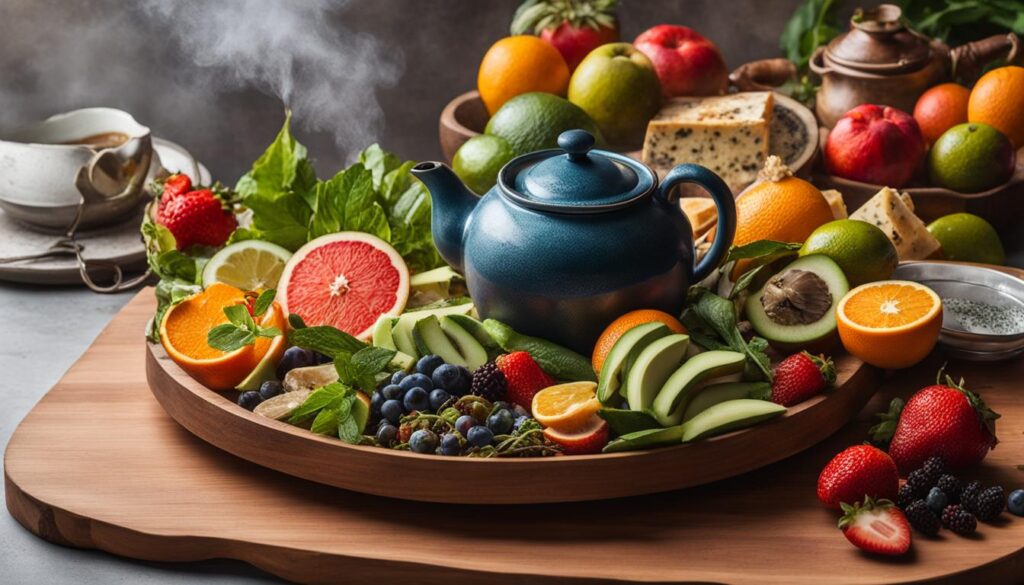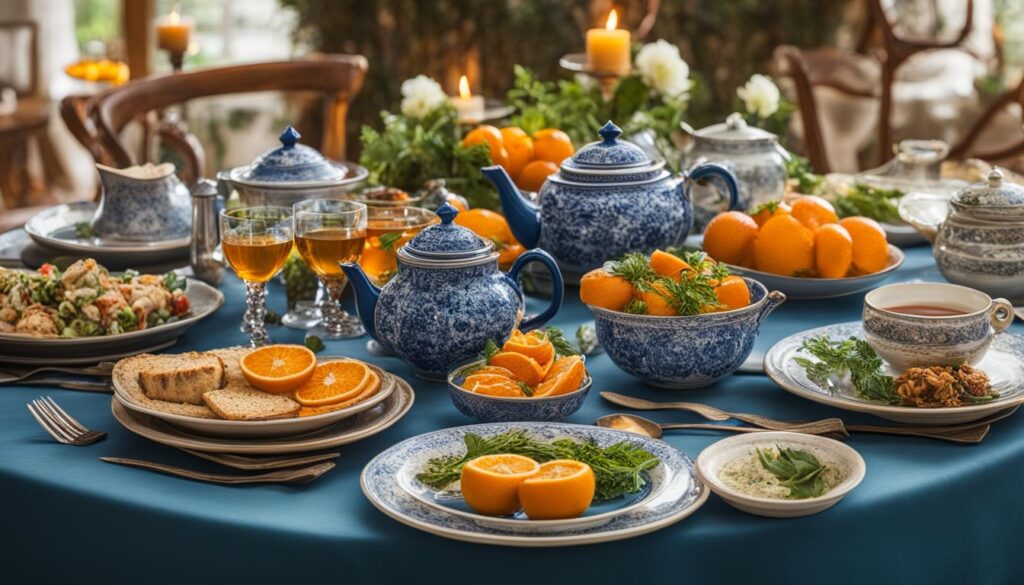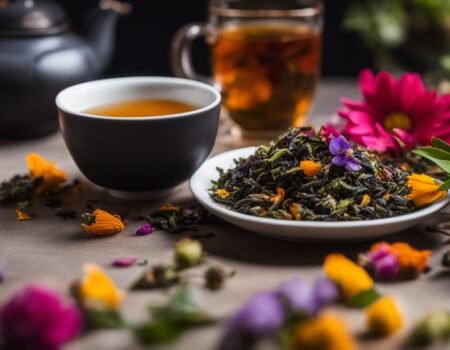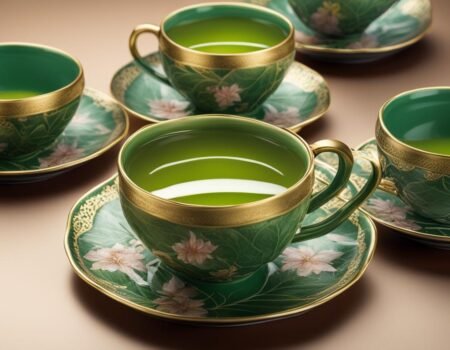
Culinary Pairings: Expert Tips for Matching Food with Tea Blends
Tea lovers rejoice! We have delved into the culinary arts of tea pairing to bring you expert tips and advice for creating the perfect synergy between food and tea. Whether you’re a seasoned tea connoisseur or just starting your tea journey, discovering the art of tea and food pairings will elevate your dining experience to new heights.
Tea has an incredible ability to complement and enhance the flavors of various cuisines, making it a versatile companion for meals. The right tea blend can bring out the delicate notes of a dish or provide a delightful contrast that tantalizes your taste buds. With our guide to tea and food synergy, you’ll unlock a world of creative and delicious food and tea pairings.
Key Takeaways:
- Pairing tea with different cuisines opens up a world of flavor combinations.
- Tea flavors can complement or contrast with the flavors of food.
- Consider the strength, astringency, and texture of both the tea and the dish when pairing.
- Each type of tea has its own unique flavor profile, offering endless pairing possibilities.
- Hosting a tea and food pairing party can be a fun and educational experience for friends and family.
Mastering the Art of Pairing: Tea and Food Guidelines
When it comes to creating the perfect tea and food pairing, there are some essential guidelines to keep in mind. Understanding the flavor profiles of both the tea and the dish is key to achieving a harmonious combination. You have the choice to either complement or contrast the flavors, depending on your preference and the desired outcome.
Consider the strength of the tea and match it with the intensity of the dish. A robust black tea might stand up well to rich and bold flavors, while a delicate green tea could be better suited to lighter, more delicate dishes. The level of astringency in both the tea and the food should also be taken into account. Astringent teas, like certain black teas, can be balanced with fatty or creamy dishes, while less astringent teas, such as white or herbal teas, pair well with lighter fare.
Another aspect to consider is the texture of both the tea and the food. Is the tea smooth and velvety or crisp and refreshing? Does the dish have a creamy or crunchy texture? Look for complementary or contrasting textures that add depth and complexity to the pairing experience. By carefully considering these aspects, you can create a tea and food pairing that delights the senses and takes your culinary experience to new heights.

Tea and Food Pairing Guidelines:
- Understand the flavor profiles of the tea and the dish.
- Choose to complement or contrast flavors.
- Match the strength of the tea with the intensity of the dish.
- Consider the level of astringency in both the tea and the food.
- Take into account the texture of the tea and the dish.
“Tea is a versatile beverage that can enhance the flavors of food and create a truly enjoyable dining experience.” – Tea Enthusiast
Pairing tea with food is an art form that allows you to explore and discover new flavor combinations. By mastering the guidelines of tea and food pairing, you can elevate your culinary journey and enjoy the wonderful synergy between these two elements.
Pairing Suggestions for Various Types of Tea
When it comes to pairing tea with food, different types of tea have distinct flavor profiles that can complement a variety of culinary delights. Whether you’re enjoying a robust black tea, a delicate green tea, or a rich and earthy pu-erh tea, there are ideal pairings to enhance your tea-drinking experience. Here are some suggestions for pairing various types of tea with complementary flavors:
Black Tea Pairings
Black tea has bold and robust flavors that pair well with equally strong flavors. Consider pairing a malty Assam black tea with a rich chocolate dessert or a spiced chai tea with savory Indian dishes. The strong flavors of black tea can also complement grilled meats and hearty dishes.
Green Tea Pairings
Green tea offers a delicate and refreshing flavor profile, making it a versatile choice for pairing with a range of foods. Match the grassy notes of a sencha green tea with sushi or sashimi for a harmonious combination. Alternatively, pair a floral jasmine green tea with light salads or seafood dishes for a fresh and vibrant pairing.
Oolong Tea Pairings
Oolong tea strikes a balance between the boldness of black tea and the delicacy of green tea. Its complex flavors make it an excellent choice for pairing with rich and flavorful foods. Try pairing a floral and fruity oolong tea with roasted duck or a nutty oolong tea with roasted vegetables for a satisfying combination of flavors and textures.
White Tea Pairings
White tea has a subtle and delicate flavor profile, making it best paired with light and delicate foods. Its gentle floral and fruity notes go well with fresh fruits, salads, and light desserts. Consider pairing a silver needle white tea with a citrusy fruit salad for a refreshing and harmonious pairing.
Pu-erh Tea Pairings
Pu-erh tea is known for its rich and earthy flavors, which pair well with hearty and savory foods. Its depth and complexity make it an excellent choice for pairing with bold cheeses, roasted meats, and flavorful stews. Consider pairing a ripe pu-erh tea with aged cheese or a young raw pu-erh tea with a spicy Sichuan dish for a unique and satisfying combination.
Herbal Infusion Pairings
Herbal infusions offer a wide range of flavors, from floral and fruity to spicy and herbal. With no actual tea leaves, herbal infusions can be paired with a variety of foods based on their individual flavor profiles. For example, a chamomile infusion can be paired with honey-based desserts, while a mint infusion can complement spicy foods. Explore the world of herbal infusions and experiment with different pairings to find your favorite combinations.
“Tea is the perfect companion for a multitude of flavors. Whether you’re enjoying a robust black tea or a delicate herbal infusion, there’s always a culinary adventure waiting to be explored.”
Pairing tea with food is an art that allows you to enhance and elevate your dining experience. By considering the flavor profiles of different teas and experimenting with complementary flavors, you can create harmonious and satisfying combinations. So, the next time you sip on your favorite tea, don’t forget to pair it with a delicious dish to unlock the full potential of tea and food synergy.
| Type of Tea | Recommended Pairings |
|---|---|
| Black Tea | Rich chocolate dessert, spiced Indian dishes, grilled meats |
| Green Tea | Sushi, sashimi, light salads, seafood dishes |
| Oolong Tea | Roasted duck, roasted vegetables |
| White Tea | Fresh fruits, salads, light desserts |
| Pu-erh Tea | Aged cheese, roasted meats, flavorful stews |
| Herbal Infusion | Honey-based desserts (chamomile), spicy foods (mint) |
Host Your Own Tea and Food Pairing Party
Bring your friends and family together for a delightful and memorable tea and food pairing party. It’s the perfect opportunity to showcase your culinary skills and explore the fascinating world of tea flavors. Let us guide you through the steps to host a successful event that will leave your guests impressed and craving for more.
Tea and Dish Selection
Start by curating a diverse selection of teas that will cater to different tastes and preferences. Consider offering a range of black, green, oolong, white, and herbal teas to provide an array of flavor profiles. Pair each tea with a carefully chosen dish that complements its unique characteristics. For example, a robust black tea would go well with rich and savory dishes like chocolate cake or roasted meats, while a delicate green tea would be a perfect match for light and fresh dishes such as cucumber sandwiches or sushi.
Tasting and Pairing Notes
As the host, it’s essential to provide your guests with tasting and pairing notes to enhance their experience and encourage meaningful discussions. Create personalized note cards for each tea and dish combination, describing the flavors, aromas, and textures they can expect. Include suggestions on how the tea and food can be enjoyed together to maximize the synergy of flavors. Encourage your guests to share their thoughts and impressions, fostering a lively atmosphere of exploration and conversation.

Exploration and Conversation
A tea and food pairing party is not only about indulging in delicious treats but also about expanding your knowledge and appreciation of tea. Encourage your guests to explore the flavors and experiment with different combinations. Facilitate conversations and discussions about their experiences, allowing everyone to share their unique perspectives and insights. This interactive and engaging atmosphere will make your party a memorable and educational event for all.
As you plan and host your tea and food pairing party, remember to enjoy the process and savor the moments of discovery. With each sip and bite, you’ll unlock a world of flavors and create lasting memories with your loved ones. Cheers to the art of tea and food pairing!
Unleashing the Power of Tea and Food Pairing
When it comes to tea and food pairing, understanding the guidelines and basic pairings can help unlock a world of harmonious flavor combinations. Each type of tea brings its own unique characteristics, and by understanding these nuances, you can create unforgettable culinary experiences.
Types of Teas and Their Basic Pairings
White Tea: Known for its delicate and subtle flavors, white tea pairs well with light and mild dishes. Consider pairing it with grilled fish, steamed vegetables, or fresh salads. The gentle nuances of white tea can enhance the natural flavors of these dishes without overpowering them.
Yellow Tea: With its slightly sweet and mellow taste, yellow tea pairs nicely with seafood, poultry, and vegetarian dishes. Its smooth and buttery profile complements the richness of dishes like roasted chicken, seared scallops, or mushroom risotto.
Green Tea: Green tea’s grassy and vegetal notes make it a versatile pairing for a wide range of cuisines. It pairs well with dishes such as sushi, stir-fries, or light pasta dishes. The refreshing and vibrant flavors of green tea can balance out the umami and saltiness of Asian-inspired dishes.
Oolong Tea: Oolong tea’s complex flavor profile, ranging from floral and fruity to toasty and earthy, makes it a versatile pairing option. It pairs well with dishes like roasted duck, pork stir-fries, or spicy noodles. The varying flavor profiles of oolong tea can complement a wide range of flavors and spices.
| Tea Type | Basic Pairings |
|---|---|
| Black Tea | Rich desserts, hearty meats, chocolate, and spicy dishes |
| Pu-erh Tea | Strong cheeses, smoked meats, bold-flavored dishes |
Pairing food with tea is like creating a symphony of flavors. The interplay between the nuances of tea and the ingredients of the dish can elevate the dining experience to new heights.
By exploring the unique characteristics of different types of teas and their basic pairings, you can unleash the power of tea and food pairing. Whether you’re hosting a tea and food pairing party or simply enjoying a meal at home, experimenting with these combinations can lead to delightful discoveries and memorable moments.
Conclusion
Tea pairing is not just about creating flavor combinations; it’s a meditative and mindful affair. The experience of matching the right tea with the right food can transport us to a realm of relaxation and satisfaction.
By understanding the basic tea pairings and exploring the nuances of flavor profiles, we can embark on a journey of discovery and delight. Whether it’s the delicate floral notes of white tea or the robust earthiness of pu-erh tea, there is a tea pairing experience for everyone to enjoy.
So, let’s embrace the joy of tea and food pairing and elevate our meals to new heights. From casual get-togethers to intimate gatherings, let the simple act of savoring a cup of tea and savoring a bite of food create lasting memories. With each sip and each bite, we can truly appreciate the relaxing and satisfying experience that tea pairing brings.
FAQ
How do I pair tea with food?
To expertly pair tea and food, consider whether to complement or contrast the flavors, match the strength of the tea with the intensity of the dish, and take into account the level of astringency and the texture of both the food and tea.
What types of tea pair well with specific foods?
Different types of tea have distinct flavor profiles. Explore the ideal pairings for black tea, green tea, oolong tea, white tea, pu-erh tea, and herbal infusions to discover the perfect culinary combinations.
How can I host a tea and food pairing party?
Gather your friends and family for a unique and memorable tea and food pairing party. Learn how to choose the right teas and dishes, provide tasting and pairing notes for your guests, and encourage exploration and conversation about their experiences.
What are the basics of tea and food pairing?
Delve into the nuances of tea flavor profiles and learn the basics of tea and food pairing. Discover the specific pairings for each type of tea, including white tea, yellow tea, green tea, oolong tea, black tea, and pu-erh tea.
How can tea and food pairing enhance my meals?
Tea pairing is a versatile and relaxing pastime that can elevate your meals without the fuss. With a basic understanding of tea flavor profiles and the right pairings, you can create a satisfying and harmonious culinary experience.






